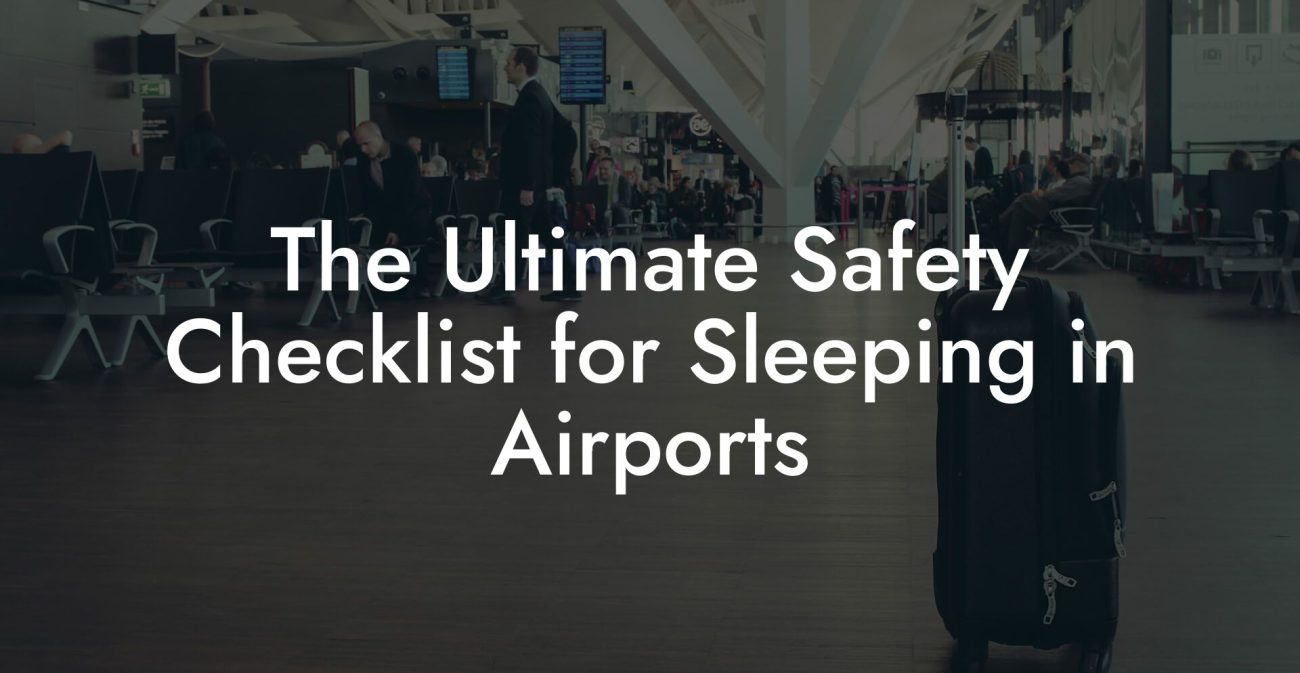Ever found yourself wandering through an airport at 3 AM with heavy lids and a mind that’s a swirling cocktail of time zones? Jet lag can hit like an unexpected plot twist in your travel adventure, turning your globetrotting dreams into a bleary, caffeine-fueled struggle. But fret not—combatting jet lag isn’t reserved for insomniac scientists alone! Whether you’re a Gen-Z minimalist or a millennial on the go, we’ve compiled the ultimate guide to sleep and wellness strategies that will have you mastering airport sleeping, nailing that elusive airport sleeping pod nap, and arriving at your destination feeling like you’ve just woken up from a luxurious spa retreat. Buckle up, because it’s time to tame your body clock and reclaim your inner zen!
Quick Links to Useful Sections
- Understanding Jet Lag: The Science Behind the Travel Hangover
- Pre-Flight Prep: Sleep, Diet, and Mindset Hacks for a Jet Lag-Free Journey
- Pre-Flight Sleep Strategy
- Smart Dietary Choices
- Mental Preparation and Mindfulness
- At the Airport: Mastering the Art of Airport Sleeping & Sleeping Pods
- Finding Your Zen in the Terminal
- The Rising Popularity of Airport Sleeping Pods
- Tips for a Restful Airport Nap
- In-Flight Sleep: Creating a Sleep-Friendly Environment in the Skies
- Optimize Your Seating Strategy
- Dress for Success (and Sleep)
- Sleep Accessories on Board
- Post-Flight Recovery: Adjusting Your Body Clock and Embracing Wellness
- Light Exposure and Circadian Rhythm Realignment
- Power Naps and Strategic Rest
- Hydration and Nutrition Reboot
- Lifestyle and Wellness Practices to Combat Jet Lag
- Exercise and Movement
- Mindfulness and Meditation
- Maintaining a Consistent Sleep Routine
- Tech and Gadgets for Travel Sleep Optimization
- Sleep Tracking and Analytics
- Light Therapy Devices
- Noise-Cancelling Devices and Sleep Sound Machines
- Expert Tips from Jet Lag Warriors: Real-Life Experiences
- Stories from the Terminal
- Millennial Movement and Gen-Z Gains
- Lessons from Frequent Flyers
- Resources and Community Support: Your Next Steps
- FAQs on Combatting Jet Lag and Mastering Airport Sleep
- Your Journey to Conquering Jet Lag and Embracing Restful Travel
Understanding Jet Lag: The Science Behind the Travel Hangover
Jet lag is more than just a quirky travel inconvenience—it’s a full-blown disruption of your body’s internal clock, otherwise known as your circadian rhythm. When you hop across time zones, your body’s natural sleep-wake cycle gets thrown off balance like a smartphone with a drained battery. The hormonal signals, the sleep hormones, and even your metabolism go haywire, making you feel out of sync and drained.
At its core, jet lag is the result of your brain struggling to adjust to sudden changes in daylight, temperature, and social schedules. Science tells us that our bodies crave consistency, and when that consistency is shattered by rapid time zone transitions, the result is a cocktail of sleepiness, irritability, and a compromised immune system. But here’s the twist: with the right sleep and wellness strategies, you can train your body to adapt faster and even start enjoying the unique rhythm of your adventurous lifestyle.
From the slow, steady beat of your favorite bedtime tunes to the science-backed strategies that recalibrate your circadian rhythm, understanding jet lag is the first step toward conquering it. Let’s dive into the inner workings of this travel phenomenon and unveil the secrets to keeping your energy levels high throughout your globetrotting escapades.
Pre-Flight Prep: Sleep, Diet, and Mindset Hacks for a Jet Lag-Free Journey
Like any epic journey, your battle against jet lag begins long before you even set foot on the plane. Pre-flight prep is your chance to optimize your sleep habits, fuel your body with the right nutrients, and set a travel-friendly mindset that will help you beat the clock—literally!
Pre-Flight Sleep Strategy
If you want to dodge the dreaded jet lag, it all starts with ensuring a good sleep before you travel. Think of it as stockpiling energy for the adventure ahead. A well-rested body is better equipped to handle the sudden shift in time zones. Consider gradually shifting your bedtime a few days before your flight to better align with your destination’s time zone. It might sound like a mini insomnia challenge, but light exposure techniques, such as using blue light filters in the evening and soaking up natural sunlight during the day, can work wonders.
Smart Dietary Choices
Food is fuel, and the right fuel can power your body through the turmoil of travel fatigue. In the days leading up to your flight, lean into a balanced, anti-inflammatory diet — think colorful fruits, leafy greens, lean proteins, and whole grains. Cutting back on heavy, greasy foods will help your digestive system stay calm and collected. And don’t forget to hydrate; your body needs water even more when you’re flying at 35,000 feet.
Mental Preparation and Mindfulness
Jet lag isn’t just a physical phenomenon—it’s also a mental game. Adjusting your mindset to expect a few travel bumps can reduce stress and anxiety. Consider meditative practices or even a few gentle yoga stretches in the lead-up to your flight. This way, you’re not only prepping your body but also your mind for the challenges of rapid time zone transitions.
With these pre-flight hacks in your toolkit, you’ll be armed and ready to take on jet lag like a pro, making your travel experience smoother and far more enjoyable.
At the Airport: Mastering the Art of Airport Sleeping & Sleeping Pods
Airports are often portrayed as chaotic labyrinths, but savvy travelers know that these spaces can offer unexpected oases of rest. With the rise of innovative airport sleeping pods and cozy lounges, catching some shut-eye on the go is no longer a distant dream—it’s a travel reality.
Finding Your Zen in the Terminal
The first step in making the most of your airport downtime is to scout out the best spots for impromptu naps. Many airports now boast dedicated napping zones, equipped with ergonomic chairs, comfy recliners, and even noise-cancelling zones to block out the ambient hubbub. If you’re lucky enough, you might find yourself in a space designed specifically for power naps, where the environment is curated with soft lighting and nature-inspired sounds.
The Rising Popularity of Airport Sleeping Pods
Airport sleeping pods are the ultimate travel hack for catching quality sleep on the fly. These high-tech capsules offer privacy, ergonomically designed seating, and a snug space that makes you forget you’re in the middle of a bustling terminal. For travelers who prioritize their sleep, these pods are a game-changer—an affordable, accessible private room to recharge your batteries before your next flight.
Tips for a Restful Airport Nap
Whether you’re slipping into an airport sleeping pod for the first time or trying out a quiet corner of the terminal, a few tricks can help maximize your nap quality:
- Earplugs and Sleep Masks: These little accessories are travel must-haves. They not only block out distracting sounds but also create a cocoon of darkness conducive to deep sleep.
- Light Stretching: Before settling in, do a few gentle stretches to relax your muscles and ease any travel-induced tension.
- Comfortable Clothing: Slip into your coziest travel attire. Loose, breathable fabrics can help you unwind, reducing any physical constraints that might hinder your zzz’s.
- Smart Device Detox: Turn off notifications or switch your phone to airplane mode to prevent your sleep from being disrupted by beeps and buzzes.
These airport sleeping strategies are designed to help you tap into quality rest—even in the midst of travel chaos. With a balance of modern amenities and simple self-care rituals, you can transform the airport from a dreaded wait zone into a rejuvenation station.
In-Flight Sleep: Creating a Sleep-Friendly Environment in the Skies
The in-flight environment is far from ideal for sleep, but with the right techniques, you can simulate the conditions of your favorite peaceful bed. Long-haul flights, in particular, demand a strategic approach to sleep—one that’s as much about planning as it is about execution.
Optimize Your Seating Strategy
Choosing the right seat can make or break your flight sleep experience. If you can, invest in an aisle seat near the emergency exit for extra legroom, or opt for one by the window to rest against the curvature of the fuselage. With a bit of luck, you might even nab a seat that reclines sufficiently to allow you to sleep without feeling like you’re cramped in a tin can.
Dress for Success (and Sleep)
Airport style isn’t just about looking chic; it’s about feeling comfortable enough to nap anywhere. Free yourself from restrictive clothing and layer up so you can adjust to the cool, conditioned air of the cabin. Compression socks, soft sneakers, and a comfortable hoodie each play a role in your airborne sleep strategy.
Sleep Accessories on Board
Bring along your travel essentials: a compact travel pillow, a soft blanket, and noise-cancelling headphones or earplugs to cocoon yourself from the flight’s din. Many frequent flyers swear by memory foam neck pillows, which cradle your head and prevent those pesky neck cramps.
While you may not be able to fully replicate your bedroom’s tranquility at 35,000 feet, you can certainly create a sleep-friendly zone that gives your body the rest it craves—even when it’s soaring through the clouds.
Post-Flight Recovery: Adjusting Your Body Clock and Embracing Wellness
Landing in a new time zone can be both exhilarating and exhausting. The trick is to transition smoothly from airplane mode to local time—a process that might take a day or two but can be accelerated with smart recovery strategies.
Light Exposure and Circadian Rhythm Realignment
Immediately upon landing, immerse yourself in the new environment. Natural sunlight is a powerful tool that signals your internal clock to adjust. Whether it’s a brisk walk in a sunlit park or simply spending time near a window, light exposure helps reset your circadian rhythm and nudges your body out of travel-induced confusion.
Power Naps and Strategic Rest
Even after landing, a well-timed power nap of 20–30 minutes can do wonders for your energy levels. Avoid the temptation to oversleep, as elongated naps may further disrupt your natural sleep cycle. Instead, aim for brief, refreshing bursts of sleep that reinvigorate without leaving you feeling groggy.
Hydration and Nutrition Reboot
After hours spent in a pressurized cabin, rehydrating is absolutely crucial. Sip on water, herbal teas, or natural electrolyte drinks to replenish lost fluids and kickstart your metabolism. Enjoy nutrient-rich meals that are light yet energizing—opt for salads, lean proteins, and fresh fruits—to gently revive your system.
With these post-flight recovery tips, you can ease the transition into a new time zone and ensure that jet lag doesn’t hijack your travel experience.
Lifestyle and Wellness Practices to Combat Jet Lag
Beyond quick fixes on the go, long-term lifestyle adjustments can have a tremendous impact on your ability to manage jet lag. Incorporating regular wellness practices into your daily routine not only helps reset your internal clock but also builds resilience against future time zone shifts.
Exercise and Movement
Keeping your body in motion is essential for maintaining a healthy circadian rhythm. Whether it’s yoga, running, or a brisk walk, regular exercise stimulates endorphin production and helps reduce stress—both critical factors in managing jet lag. Even simple stretching routines can alleviate muscle stiffness and improve blood circulation, allowing you to move with greater ease after a long flight.
Mindfulness and Meditation
Embrace mindfulness practices to alleviate the mental fog that often accompanies jet lag. Meditation, deep breathing exercises, and even short moments of quiet reflection can help stabilize your mood and align your internal clock. Consider using a meditation app to guide you through short, effective sessions that can be squeezed into your travel schedule.
Maintaining a Consistent Sleep Routine
Although travel can disrupt even the most disciplined routines, striving for consistency in your sleep schedule—even on vacation—can speed up your body’s readjustment process. Establish a regular bedtime and wake-up time, and try to mimic those patterns as closely as possible no matter where you are on the globe.
Integrating these wellness practices into your everyday life not only enhances your resistance to jet lag but also contributes to a robust, vibrant lifestyle that supports your travel adventures.
Tech and Gadgets for Travel Sleep Optimization
Technology is constantly evolving, and it’s come to the rescue of sleep-deprived travelers everywhere. From sleek sleep-tracking devices to apps designed to adjust your circadian rhythm, these innovative tools can provide an extra edge in your battle against jet lag.
Sleep Tracking and Analytics
Wearable sleep trackers can monitor your sleep quality in real time, offering insights into your sleep cycles, heart rate, and overall restfulness. By analyzing this data, you can adjust your sleeping patterns and tailor your environment to maximize rest. Many fitness apps now come equipped with features that help you set personalized sleep goals and offer gentle nudges to stay on track.
Light Therapy Devices
Portable light therapy devices are designed to mimic natural sunlight, helping to re-synchronize your body clock no matter where you are. These gadgets emit a controlled, bright light that tricks your brain into thinking it’s earlier or later than it actually is, providing a non-invasive way to manage jet lag.
Noise-Cancelling Devices and Sleep Sound Machines
In the noisy chaos of airports or turbulent airplane cabins, noise-cancelling headphones and sound machines can create a peaceful auditory environment for sleep. Whether it’s the white noise of a gentle rain or the calming sounds of nature, these devices are indispensable for fostering a serene sleep ambiance.
With the right blend of tech-savvy tools at your disposal, you can transform even the most challenging travel conditions into opportunities for restorative sleep and wellness.
Expert Tips from Jet Lag Warriors: Real-Life Experiences
Sometimes, the best advice comes from those who have already braved the skies and lived to tell the tale. Jet lag warriors—seasoned travelers who’ve turned the art of combating sleep disruption into a science—have a treasure trove of tips to share.
Stories from the Terminal
Meet Alex, a digital nomad who swears by his pre-flight routine that includes a power nap and a carefully planned diet. “I once caught a 90-minute nap in an airport sleeping pod, and it was a game-changer,” he laughs. Alex credits his consistent sleep patterns and strict adherence to light exposure routines for his ability to bounce back from even the most grueling flights.
Millennial Movement and Gen-Z Gains
Then there’s Sam, a millennial globetrotter who has mastered the in-flight sleep hack. With the aid of his trusty noise-cancelling headphones and a custom-curated sleep playlist, Sam has turned long-haul flights into restful retreats. “I don’t just travel—I travel smartly, with every tool at my disposal to fight off jet lag,” he boasts, sharing screenshots of his sleep tracker’s impressive stats.
Lessons from Frequent Flyers
These real-life experiences reveal that while jet lag might be inevitable, its impact is entirely manageable with the right blend of preparation, modern technology, and a sensible dose of humor. The key is in treating each journey as an opportunity to experiment, learn, and ultimately, thrive.
Resources and Community Support: Your Next Steps
The battle against jet lag is as much a personal journey as it is a community endeavor. Around the globe, fellow travelers, sleep experts, and wellness enthusiasts have congregated online and in travel hubs, ready to share tips, trade experiences, and support each other on the road to well-rested adventures.
Explore travel forums and social media groups dedicated to flight hacks and travel wellness. Websites like Reddit’s r/travelhacks and dedicated travel wellness blogs offer a treasure trove of firsthand advice and product recommendations. Additionally, you can subscribe to newsletters from sleep experts who specialize in circadian rhythm science—each piece of advice is crafted to help you master time zones and reclaim your sleep.
Finally, consider joining local meetups and online communities where frequent flyers swap stories, troubleshoot challenges, and celebrate mini-victories in the fight against jet lag. These connections not only provide practical advice but also reaffirm that no matter how far you roam, you’re never truly alone in your quest for wellness.
With the right resources and a supportive network, your next steps toward a jet lag-free life are well within reach. Immerse yourself in the community, experiment with innovative sleep strategies, and embrace your journey as an evolving adventure in health and travel.
FAQs on Combatting Jet Lag and Mastering Airport Sleep
Got questions about optimizing sleep during travel and allying with jet lag? Check out these frequently asked questions that address common concerns and offer actionable advice to help you conquer travel fatigue with humor and science.
1. What exactly causes jet lag?
Jet lag results from a rapid disruption of your circadian rhythm when traveling across multiple time zones. This creates a mismatch between your internal body clock and the new local time, resulting in fatigue, irritability, and sometimes digestive issues.
2. Can I adjust my sleep schedule before traveling?
Yes! Gradually shifting your sleep schedule a few days before your flight by altering your bedtime and wake-up time can significantly reduce the severity of jet lag.
3. Are airport sleeping pods worth it?
Absolutely. Airport sleeping pods offer a private, comfortable space to catch some quality rest and are an excellent alternative to trying to sleep on busy terminal benches.
4. What are some effective in-flight sleep strategies?
Optimize your seat selection, dress comfortably, and bring sleep accessories like neck pillows and noise-cancelling headphones. Following a consistent sleep routine and minimizing in-flight distractions are essential strategies.
5. How can light therapy help with jet lag?
Exposure to controlled bright light can help reset your internal clock, signaling to your body that it’s time to wake up or wind down, depending on your needs. Portable light therapy devices are especially useful during travel.
6. What role does nutrition play in mitigating jet lag?
A balanced diet that avoids heavy, greasy foods and emphasizes hydration and anti-inflammatory nutrients helps keep your body in peak condition, making it more resilient to the stresses of travel.
7. Are there mobile apps that help with adjusting to new time zones?
Yes, several mobile apps can guide you through adjusting your circadian rhythm by suggesting optimal sleep times and light exposure routines, based on your travel itinerary.
8. Can mindfulness practices reduce jet lag symptoms?
Definitely. Meditation, deep breathing, and other mindfulness practices help alleviate stress and promote relaxation, which can reduce the physical and mental burdens of jet lag.
Embracing these tips can turn your travel exhaustion into a well-managed adventure, setting the stage for a more energetic and enjoyable journey.
Your Journey to Conquering Jet Lag and Embracing Restful Travel
The world is a vast playground, and jet lag should never be the villain that steals your joy. By embracing cutting-edge sleep strategies, innovative sleep pods in airports, and holistic wellness practices, you’re not simply defeating jet lag—you’re rewriting the rules of travel. Every clever hack, every pre-flight adjustment, and every mindfulness moment is a stepping stone toward a future where you arrive at your destination energized, refreshed, and ready to soak in every experience.
Your travel journey is uniquely yours, and the power to master it lies within your hands (and maybe your sleep tracker, too). Experiment with the tips outlined in this guide, mix and match what works best for you, and let each journey be a lesson in self-care and resilience. The next time you board a plane, you’ll do so armed with the confidence and know-how to combat jet lag head-on.
Remember, travel is about embracing the unexpected and finding joy even in the chaos of airports and cramped airplane seats. With these sleep and wellness strategies, you’re set to transform even the most turbulent flights into opportunities for rejuvenation and self-growth. So, next time the travel bug bites, show jet lag who’s boss and embark on your adventures with energy, enthusiasm, and a healthy dose of well-earned rest.
Your journey to conquering jet lag and embracing restful travel starts today. Enjoy exploring the world, one well-rested adventure at a time!
Useful Interruption: Dive deeper into the world of airport sleeping guides with our most popular sections. If there is anything you think is missing or anything you would love for us to write about, just give us a shout.
- General Airport Sleeping Guides
- Travel Gear & Equipment Recommendations
- Regional and Airport-Specific Guides
- Airport Sleeping Pods & Reviews
- Health, Safety, and Comfort Tips for Airport Sleepers
Last week, I decided to try the world-famous "airport sleepover" experience. Imagine this: I'm lying on a bench in Terminal C, surrounded by suitcases that have seen more of the world than I ever will, and a PA system that sounds like a karaoke machine on a sugar rush. I pull out my travel pillow—which, by the way, is more like a sad deflated balloon—and declare, "Tonight, I’m the king of this terminal!"
Soon enough, fellow travelers become my unexpected audience. One guy, fresh off a red-eye, whispers, "Hey, do you think if we sleep long enough, we can catch our flight in our dreams?" I reply, "Sure, and maybe I'll even get an upgrade to first-class in my nap!" The airport lights flicker like a disco ball, and every time someone announces a delayed departure, it’s like a punchline to our impromptu stand-up routine.
As I finally drift off, I dream of a world where boarding passes are like VIP tickets to the best sleepover party ever—a party where the only baggage is the laughter you carry with you. Waking up, I realize the airport is still the same, but I now hold the honorary title of "Terminal Comedian," a title I wear with as much pride as my permanently mismatched socks!










